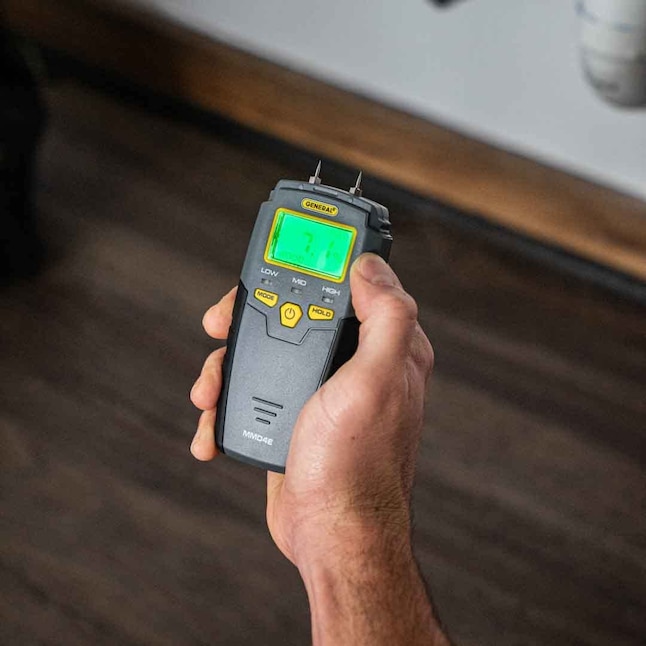How a Moisture Meter Can Aid You Maintain Optimum Conditions in your house or Office
Wiki Article
Delve Into the World of Moisture Meters: Every Little Thing You Required to Know
In the realm of wetness meters lies a globe of accuracy and usefulness that typically goes undetected. Comprehending exactly how moisture meters operate, the various types readily available, and their varied uses can shed light on their significance in making sure quality and efficiency.How Moisture Meters Work
Moisture meters operate by gauging the electrical conductivity or capacitance of products to identify the dampness material existing. These meters are very useful devices throughout numerous sectors, consisting of agriculture, building and construction, and woodworking. By making use of different approaches such as pin-type or pinless technology, moisture meters offer accurate analyses that assist experts make informed choices.
Pin-type dampness meters work by putting the sharp pins right into the product being tested. On the other hand, pinless moisture meters use electro-magnetic signals to scan a bigger area without triggering any type of damage to the material's surface.
No matter the approach made use of, dampness meters play a critical function in protecting against problems such as mold growth, architectural damages, or product problems triggered by excess wetness. Comprehending how these meters work is important for guaranteeing the quality and honesty of materials in different applications.
Kinds Of Moisture Meters
Provided the crucial duty dampness meters play in numerous markets, it is necessary to comprehend the different types available to specialists for precisely examining moisture degrees - Moisture Meter. There are mainly 2 major kinds of dampness meters: pin-type and pinless moisture meters

On the various other hand, pinless dampness meters utilize electromagnetic sensor plates to scan a bigger area of the product without creating any type of damages. This type is suitable for promptly scanning large locations and is commonly made use of for flooring, walls, and ceilings. Pinless meters are convenient for taking readings on finished surface areas without leaving any type of noticeable marks.
Both sorts of wetness meters have their advantages and are chosen based upon the certain requirements of the task handy. Understanding the distinctions in between these types is critical for experts to make exact dampness evaluations.
Applications Across Industries
With varied capabilities, dampness meters locate widespread application across various industries, aiding specialists in guaranteeing ideal problems for materials and structures. In the agriculture industry, wetness meters are vital for identifying the dampness material in grains, seeds, and hay, making sure top quality control and avoiding mold and mildew growth. Building experts rely upon wetness meters to examine the moisture degrees in structure materials like concrete, wood, and drywall, which is essential for keeping structural stability and stopping issues like rot or mold and mildew. The floor covering sector makes use of dampness meters to gauge the dampness web content in subfloors before mounting different flooring treatments, protecting against pricey damages due to excess moisture. Moreover, in the food market, wetness meters are utilized to keep an eye on and control moisture degrees in items such as grains, nuts, and dried fruits to preserve freshness and high quality. In addition, dampness meters play an essential role in the remediation and damage control market by aiding specialists address and identify water damages in buildings without delay. Throughout these varied sectors, dampness meters are essential devices for making certain the quality, safety and security, and long life of different products and items.Tips for Using Moisture Meters
Make use of the dampness meter's calibration setups to guarantee exact readings when determining the dampness content in different products. Furthermore, make sure the meter is established to the pop over to these guys appropriate dampness array for the material you are measuring to acquire the most precise results.When using a pin-type wetness meter, put the pins to the appropriate depth suggested for the product being examined. This makes sure that the moisture analyses are extracted from the correct deepness within the material, giving a much more exact representation of its moisture material. For pinless wetness meters, bear in mind to keep appropriate call with the product's surface to get dependable analyses.
Consistently check and change the batteries in your wetness meter to stop imprecise analyses as a result of low power. Shop the meter in a risk-free and dry area when not being used to prolong its life-span and preserve its precision. By complying with these suggestions, you can maximize the performance of your wetness meter and get accurate moisture material measurements throughout different materials.
Maintenance and Calibration
To ensure the accuracy of moisture content dimensions, normal maintenance and calibration of the dampness meter are vital actions in its browse around this site proper performance. Maintenance includes maintaining the dampness meter free and tidy from debris that could affect its analyses. It is very important to adhere to the producer's standards for cleaning to avoid damages to the device. Additionally, regular calibration is required to verify the precision of the analyses. Calibration readjusts the dampness meter to make certain that it supplies regular and trusted outcomes.Calibration should be done occasionally, especially if the wetness meter is utilized regularly or in important applications where precise measurements are called for. By maintaining and calibrating the dampness meter frequently, users can trust the accuracy of the moisture content dimensions gotten.
Final Thought

Finally, dampness meters play a critical role in different markets by precisely measuring the wetness material of products. Recognizing how these devices work, the different types offered, and proper maintenance and calibration are vital for obtaining reputable outcomes. Whether in farming, building, or production, using dampness meters helps make sure quality control and effectiveness in processes.

In final thought, wetness meters play an important duty in different sectors by accurately determining the dampness web content of products.
Report this wiki page